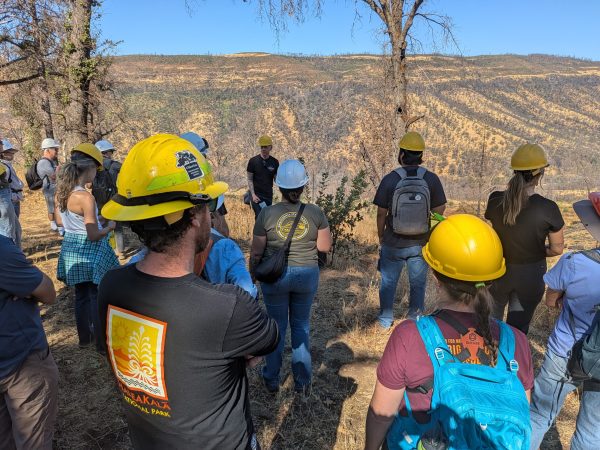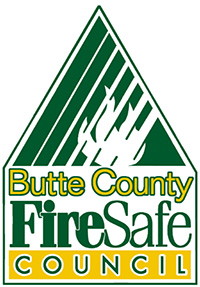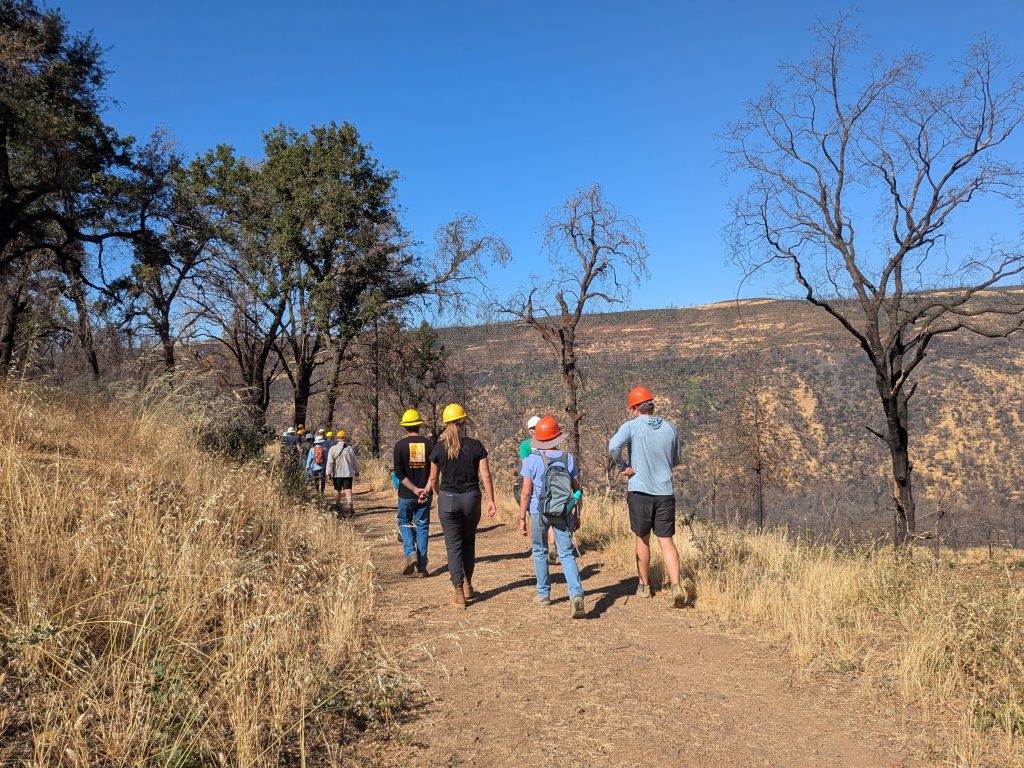On Monday, September 22, 2025, the Butte County Collaborative Group coordinated a tour of the Big Chico Creek Ecological Reserve (BCCER). The 7,835-acre reserve is located on the ancestral land of the Mechoopda Indian Tribe. The mission of BCCER is to preserve and steward critical habitat and to serve as a natural area for research and education. The BCCER has been closed to the public since the 2024 Park Fire but is anticipated to re-open in the coming months. Tour participants had the opportunity to learn about the post-fire work that has been conducted for erosion control, sediment capture, and other remediation efforts.
The tour was led by Eli Goodsell, BCCER Executive Director, Rhianna Dutra, Environmental Compliance & Planning Manager, and Mitch Bamford, Fire and Flora Manager. Eli explained that the reserve was extensively impacted by the Park Fire in July of 2024 as most of the reserve’s 7,835 acres were subjected to intense fire and the majority of BCCER’s infrastructure was lost making it difficult for BCCER staff to have adequate resources to work in the area. Despite the difficulties, BCCER staff focused on “opportunities” that the wildfire has brought to the land and their team culture. The priority on the reserve after the Park Fire was to project habitat in Big Chico Creek by slowing water down and reducing sediment in the creek. With the help of the Mechoopda Indian Tribe, Butte County Resource Conservation District, Butte County Fire Safe Council, California Conservation Corps, Mooretown Rancheria, and City of Chico, the BCCER team implemented erosion control measures installing sediment retention structures and captured nearly 60,000 cubic feet of sediment.

After the Park Fire, BCCER was reportedly exposed soil without vegetation cover. The State of Emergency declaration allowed for streamlined permitting for erosion control. Permitting for the post fire erosion control project at BCCER was completed by the Butte County Resource Conservation District. The importance of relationships with permitting agencies was discussed during the tour. Partners and agencies reportedly came together to create a mitigation plan for the project. However, the US Army Corps of Engineers only allowed in-stream work to occur where it saved infrastructure, so work had to stop at the road. BCCER staff emphasized that many lessons were learned through this process, one being that it is important to start at the top of ephemeral streams to control sediment transport. In addition, Rhianna explained that the project team made the waddles at BCCER to avoid off site seeds from coming in but would not recommend it in the future.
Tour participants also learned about the ongoing Musty Buck Ridge fuel break project funded by the Sierra Nevada Conservancy which will create future prescribed burn access in addition to a wildfire fuel break. This project is the first to use herbicide application on the reserve to date. Eli explained that it has been a learning opportunity as every tool can be beneficial at the right time and scale. BCCER’s goal is to preserve diverse species. The herbicide was used to target ceanothus. In terms of replanting, Blue Oak is the only target species that is a needed candidate for replanting. Regrowth has been rapid on the landscape. BCCER is planning to put prescribed fire in meadow habitats this fall. Eli explained that the reserve has the resources on site to do projects with approximately 40 wildland firefighters and at least 2 burn certified burn bosses on staff.
Tour participants were encouraged to hear that wildlife is returning to Big Chico Creek Ecological Reserve slowly but surely. Deer counts are currently lower than usual, quail and bears are back, and snakes are steadily returning. A new butterfly species and new plant species have been observed as well. BCCER staff shared that the public will be welcomed back to BCCER soon!

